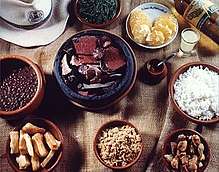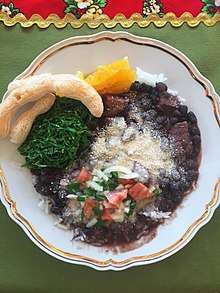Feijoada
Feijoada (Portuguese pronunciation: [fejʒuˈadɐ]) is a stew of beans with beef and pork. It is commonly prepared in Portugal, Brazil, Angola, Cape Verde, Guinea-Bissau, Mozambique, Timor (West Timor and East Timor),[1] Goa, and Macau, where it is also considered a national dish. However, the recipe differs slightly from one country to another.[2]
 Brazilian-style feijoada with common side dishes | |
| Type | Stew |
|---|---|
| Place of origin | Portugal, Brazil |
| Main ingredients | beans, beef, pork |
| Variations | typ |
The name comes from feijão, Portuguese for "beans".
The basic ingredients of feijoada are beans with fresh pork[3] or beef. In Brazil, it is usually made with black beans (feijoada à brasileira). The stew is best prepared over low heat in a thick clay pot.
It is usually served with rice and assorted sausages such as chouriço, morcela (blood sausage), farinheira, and others, which may or may not be cooked in the stew.
The practice of cooking a meat (pork) stew with vegetables that gave origin to the feijoada from the Minho Province in Northern Portugal is a millenary Mediterranean tradition that can be traced back to when the Romans colonized Iberia.[4] Roman soldiers would take this habit to every Latin settlement, i.e., all of the provinces of Romania, the Vulgar Latin--speaking area of Europe (not to be confused with the modern country solely), and this heritage is the source of many national and regional dishes of today's Europe, such as the French cassoulet, the Milanese cassoeula from Lombardy, Italy, the Romanian fasole cu cârnați, the fabada asturiana from Northwestern Spain, and the also Spanish cocido madrileño and olla podrida, not to mention non-Romanic regions with similar traditions that might be derived from this millennial Roman soldiers' dish like the Polish golonka.[4][5]
Fasolada, labeled the Greek national dish, is related to the ancient Greek dish of broad beans, vegetables, and grains, with no meat, unlike the Italian fagiolata and the Portuguese feijoada, which was used as food and sacrifice to Greek God Apollo during the Pyanopsia festival.[6][7][8][9]
Variants
Many modern variants of the dish are based on feijoada recipes popularized in the Brazilian regions of Rio de Janeiro, São Paulo, Recife, and Salvador. In Brazil, feijoada (feijoada brasileira) is often considered a national dish.
Brazilian feijoada
Registered for the first time in Recife, State of Pernambuco, feijoada has been described as a national dish of Brazil, especially of Rio de Janeiro, as other parts of Brazil have other regional dishes.[10][11] The Brazilian version of feijoada (feijoada brasileira) is prepared with black beans,[3] a variety of salted pork or beef products, such as pork[3] trimmings (ears, tail, feet),[3] bacon, smoked pork ribs, and at least two types of smoked sausage and jerked beef (loin and tongue). In some regions of the northeast, like Bahia and Sergipe, vegetables like cabbage, kale, potatoes, carrots, okra, pumpkin, chayote and sometimes banana are frequently added, at the end of the cooking, on top of the meat, so they are cooked by the vapors of the beans and meat stew. The final dish has the beans and meat pieces barely covered by a dark purplish-brown broth. The taste is strong, moderately salty but not spicy, dominated by black bean and meat stew flavors. It is customary to serve it with white rice and oranges, the latter to help with digestion, as well as couve, a side dish of stir-fried, chopped collard greens or kale, and a crumbly topping called farofa, made of manioc flour.
Feijão com arroz is the rice and beans without the addition of the meat and is not considered as feijoada.

Depending on the region of Brazil, the type of bean used in feijoada varies. While in some regions like Rio de Janeiro or Minas Gerais, feijoada is typically prepared with black beans, others in Goias and Bahia brown or red is preferred.
As a celebratory dish, feijoada is traditionally served on Saturday afternoons or Sunday lunch and intended to be a leisurely midday meal. It is meant to be enjoyed throughout the day and not eaten under rushed circumstances. The meal is usually eaten among extended family and paired with an event like watching a soccer game or other social event. Because of the dish's heavy ingredients and rich flavors, feijoada is viewed as Brazilian soul food. In the city of São Paulo, feijoada is a typical dish in working-class restaurants on Wednesdays and Saturdays, mainly in the commercial area. In Rio de Janeiro, restaurants traditionally serve it on Fridays.[12] The dish is normally served with a choice among a selection of meats, e.g. pork, bacon, pig ears, pig feet, to fulfill the customer`s needs. Other variations of feijoada, such as the low fat version or the vegetarian.[13] The dish is frequently compared to American Southern Soul Food, which shares many similarities in terms of ingredients and taste.[14]
According to legend, the origins of Brazil’s national dish, feijoada, stem from its history with slavery. Slaves would supposedly craft this hearty dish out of black beans and pork leftovers given to them from their households. These leftovers included pig feet, ears, tail, and other portions seen as unfit for the master and his family. However, the theory has recently been contested to be considered a modern advertising technique rather than its origin. Instead, scholars argue that the history of feijoada traces back to Brazil’s cultivation of black beans. Because of the crop’s relatively low production cost and the simplicity of its maintenance, the beans became a staple food among European settlers in Brazil. Although both the upper-classes and the poor ate black beans, the upper-classes particularly enjoyed them with an assortment of meat and vegetables, similar to feijoada. In contrast, the poor and enslaved usually ate a mixture of black beans and manioc flour.[15]
Nutrition
Feijoada is traditionally consumed with orange slices as a side dish, which is likely to increase the bean's iron absorption.[16]
See also
References
| Wikimedia Commons has media related to Feijoada. |
- https://honest-food.net/portuguese-feijoada-recipe/
- "Archived copy". Archived from the original on 2016-06-02. Retrieved 2016-02-09.CS1 maint: archived copy as title (link)
- Multicultural America: An Encyclopedia of the Newest Americans - Google Books p. 180.
- "A feijoada não é invenção brasileira. Todo mundo acha que os inventores foram os escravos. Mas o prato já era apreciado na Europa desde os tempos do Império Romano". Super Interessante. Retrieved 10 September 2016.
- "O mito da feijoada, cuja real origem é lusitana". UOL educação. Retrieved 10 September 2016.
- August Mommsen
- Nancy Evans, Civic Rites: Democracy and Religion in Ancient Athens, 2010, ISBN 0520262026, p. 180
- Dictionnaire Grec Ancien -Français
- Αθήναιου Δειπνοσοφισταί, Βιβλίο Θ', 408a
- "A feijoada não é invenção brasileira" (in Portuguese). Superinteressante. Retrieved 26 June 2017.
- "O Carapuceiro (jornal)" (in Portuguese). Fundaj. Retrieved 26 June 2017.
- Hinchberger, Bill (2014). National Geographic Traveler: Brazil. National Geographic Society. p. viii. ISBN 9781426211645.
national dish of Brazil black beans pork Friday.
- Fajans, Jane (2013-07-18). Brazilian Food: Race, Class and Identity in Regional Cuisines. A&C Black. ISBN 9780857850430.
- Lam, Francis (2015-05-27). "Brazilian Soul Food". The New York Times. ISSN 0362-4331. Retrieved 2016-02-23.
- Elias, Rodrigo. "Feijoada: A short history of an edible institution." Flavors from Brazil. Brasília: Ministry of External Relations, 2008. "Archived copy" (PDF). Archived from the original (PDF) on 2016-02-22. Retrieved 2016-02-23.CS1 maint: archived copy as title (link)
- Teucher; Olivares; Cori (2004-11-01). "Enhancers of Iron Absorption: Ascorbic Acid and other Organic Acids". International Journal for Vitamin and Nutrition Research. 74 (6): 403–419. doi:10.1024/0300-9831.74.6.403. ISSN 0300-9831. PMID 15743017.